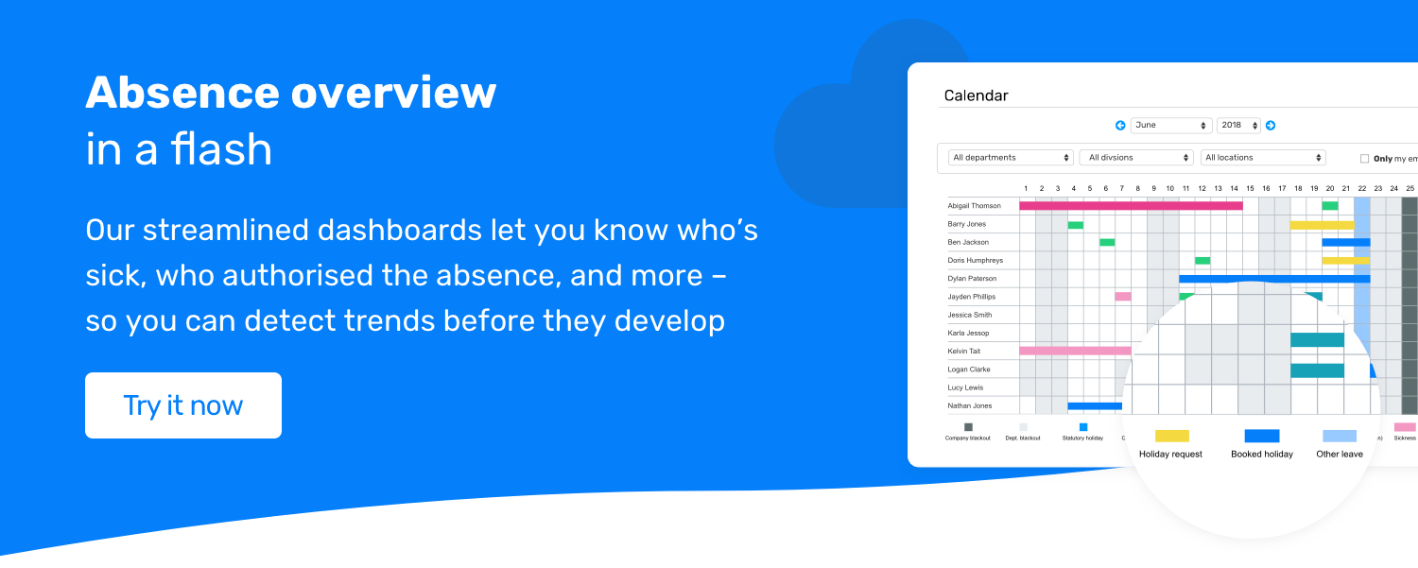This may seem over-simplified – but when looking at the divide between what UK businesses are offering as wellbeing supports (we’ll dive further into this later) and current sickness absence rates, it seems like we’re missing something.
Whilst well-meaning, the CIPD asserts that traditional wellbeing initiatives aren’t doing enough to support the way we work now:
“Investing in employee wellbeing can lead to increased resilience, better employee engagement, reduced sickness absence and higher performance and productivity. However, wellbeing initiatives often fall short of their potential because they stand alone, isolated from the everyday business.
To gain real benefit, employee wellbeing priorities must be integrated throughout an organisation, embedded in its culture, leadership and people management.”
Lucy Adams’ approach to HR is a radical one, which supports the CIPD argument. Lucy’s organisation, Disruptive HR, essentially encourages trusting your people to use their judgement & do the right thing, and less policies – far less policies, in fact.
Lucy offered some advice in our recent webinar on how SMEs can build a supportive approach & environment for their teams – by really focussing on what matters most to their people (and removing a lot of stress along the way).
Why traditional wellbeing approaches aren’t working
In the webinar, Lucy Adams noted that wellbeing is everywhere – but sadly, often in the form of free snacks & fizzy drinks. She questions whether the $53 billion (£43.3 billion) global spending on corporate wellbeing initiatives are driving the results we deserve & want – and suspects the answer is no.
Lucy emphasises that we need to consider wellbeing in a way that genuinely impacts on people’s health and wellbeing, by talking to them. Traditional wellbeing approaches focus on giving people lots of information, often in a parental manner of taking screen breaks, or drinking water. Lucy’s ethos is that HR shouldn’t play the role of looking after people like they’re children – however well-intentioned, HR should treat employees like adults (and not simply offer Zoom yoga, or fruit baskets in the office).
Whilst Lucy acknowledges that some wellbeing initiatives do have an impact and are useful to people (such as Employee Assistance Programmes, or financial support such as debt counselling), to get to the wellbeing that matters, businesses & HR need to consider a holistic approach to what works for their team.
Why wellbeing initiatives don’t stick
Ruth Wragg-Jones explained that clients often ask why their wellbeing practices aren’t sticking. Ruth advises that you have to really understand your organisation – you can’t simply just ‘bolt-on’ an activity and hope it’ll work.
Consider what your management style is like, or what your hierarchy is like within your SME – do people feel they need to ask permission to join in? Do people even have time, or capacity for any initiatives, or is this just adding to the problem and causing stress?
How SMEs can reduce sickness levels with wellbeing that works
Lucy believes that what really creates health & wellbeing is being trusted to be autonomous, to do your job well and to have the flexibility that matters to you as an employee.
The model she advises that creates authentic wellbeing that works, is for employers to:
- Show trust and flexibility
- Show care
- Remove the hassle
Sounds simple, doesn’t it? But also a bit daunting if you’ve not encountered this type of HR before – we understand. The good news is, getting to the core of what your people need & value at work doesn’t have to break the bank – and might be easier than you think to implement.
In this section, we’ll take a closer look at each of these areas, with real-world examples of companies who have displayed the behaviours that make a difference.
1. Trust and flexibility
“We know that when you [as an employee] are in an environment where you believe you are trusted - trusted to know what’s right for you, trusted to use your judgement, trusted to work in ways that play to your strengths, that fit in with your lifestyle or home commitments, maybe your hobbies...
when you feel that level of trust & the flexibility to feel more autonomous – you’re much less likely to feel high levels of burnout, you are much more likely to feel less stress, to be more productive, to feel happier in your workplace.”
Lucy Adams, Boosting workplace wellbeing webinar.
This is the deeper, crucial cultural foundation of the wellbeing puzzle – without this, Lucy says that a sticking plaster of wellbeing initiatives that aren’t really valued by your team just aren’t going to work (and your sickness levels are likely to be high).
Examples of businesses showing trust & flexibility:
-
Removal of probation periods
SMART energy, Virgin Atlantic & PWC are all companies that no longer offer probation periods. Lucy advises that a ‘probation’ period in itself sounds like criminal language in a sense. If the businesses have trusted someone enough to hire them, pay them, allow them to interact with customers etc. then there shouldn’t be a need for a trial period in this way.
Virgin discovered that on average, just 2 people a year out of 10,000 staff failed their probation period - so removed it.
-
Paid time off to exercise
Patagonia offer their team paid time off for exercise and movement – and trust them to manage this within their work time. Supporting wellbeing in this way means that employees have valuable time for their physical & mental health, with the full support and trust of the company behind them.
-
Golden time
Rather than asking permission to make a doctor’s appointment or pick the kids up – at Harry’s, employees are trusted to behave decently by putting ‘golden time’ in their calendar. Lucy also references Slack’s use of the ‘do not disturb’ feature, allowing employees to have a break from notifications to achieve headspace, if they need it.
-
Individual approaches to flexible working
At HubSpot – it’s acknowledged that employees have different needs, and work better in different environments. Lucy states that treating everyone with the same rule with regards to hybrid working (e.g. 3 days a week in the office for all) is old-fashioned, doesn’t offer true flexibility & removes personal choice.
Of course, working arrangements need to be discussed with managers & work within teams, but Lucy is keen for HR to move away from the role of compliance manager, and to encourage managers to have these conversations with their teams.
2. Showing care
Showing care for your people can often be overlooked – especially when managers are overwhelmed or overloaded, Ruth Wragg-Jones, OD Manager at Fitzgerald HR points out.
Ruth advises that checking in and simply asking how people are is the best approach – prioritising natural instincts over policies that can keep managers overwhelmed and ‘straight-jacketed’ with how they feel they should react. Ruth likens the term ‘return-to-work interview’ as a daunting one, with the word ‘interview’ suggesting a balance of power gone askew.
Examples of businesses who show they care:
-
Stay conversations
Dropbox are keen to encourage ‘stay’ conversations, especially over exit interviews, when it’s too late for anything to be done. Dropbox identified flight risks within their business and got their managers talking to these people to find out what they could do to make it a better working environment. Through having these short, informal, undocumented conversations, Dropbox managed to retain a huge 96% of those they identified as flight risks.
Lucy advises these conversations remain informal, and that managers could have just a few questions to ask people what could make a difference in their work – e.g. “If you were managing you, what would you do differently?” Something worth mulling over.
-
Listening
At F5, managers put effort into genuinely asking their team the right questions, regularly. Rather than once a year in an annual engagement survey, F5 kept their ears to the ground with pulse surveys to tap into what their people were thinking & how they were feeling. Lucy notes that this helps businesses to be more agile and respond much more quickly to feedback.
-
Personal preference profile
Kimpton understands that their people have different likes, dislikes, needs and preferences. They took the time to really understand their team, by asking questions such as “how do you like to be communicated with?” and “what’s your most productive time of day?” Simple – but hugely effective in showing your employees you care about them as individuals.
3. Remove the hassle
Lucy advises HR to think about what they can take away, rather than what additional frameworks they need to bring in/what extra things they can do.
She advises that “tonnes of rules scream [to your people] ‘we don't trust you!'
Heavy workloads, more policies, coupled with too many expectations are all easily a recipe for stress – so Lucy’s advice is to get rid of what you don’t need, like the following businesses.
Examples of businesses who have removed the hassle:
- Get rid of stupid rules
PepsiCo removed policies that got in the way of people doing their best work. They asked their teams what policies stopped them from working as efficiently as they could be, and then removed them.
- If it works, keep it – if not, dump it
In the same vein, Spotify’s ethos is to keep the policies that work, and to remove the ones that don’t. Refreshing, isn’t it?
You can hear Lucy and Ruth discuss these examples further (along with insightful audience questions) in the on-demand webinar.
How can your SME truly support employee health & wellbeing?
To truly support your people’s health and wellbeing (and hopefully in turn, reduce stress levels and sick days) consider a holistic view – both for HR in terms of what does the organisation need as a whole, and for managers on an individual level.
For example, start opening up conversations, or thinking about what this person might need in order to feel supported at work, reduce stress levels and be their most productive?
The more trusted and autonomous they are, the happier people are likely to feel at work. With this, means less likelihood of stress & burnout that can cause illness.
Start a conversation in your SME today, and consider what wellbeing really means to your organisation.
Breathe’s absence management software can help you to store sickness records securely & easily. Trial for free, today.







